2017 Yamaha Ar210 Top Speed
Brief Summary
Affordable can be a nasty word in the marine industry. Most often it translates to "stripped down" but Yamaha seems to take the term more seriously, and does so without compromising its integrity. With the Yamaha 210 Series, we see two boats that offer a spacious layout, versatility, and quality components like the Connext touchscreen. All in an easily handled 21'3" (6.48m) package that actually is… affordable.
Key Features
- Snap-in soft marine-grade carpet
- Removable dinette table with pedestal
- Integrated Removable Cooler
- Integrated Swim Platform
- Stern Wet Storage
- 3 position No Wake Mode Control
- Colors available in Maple Red or Suede Gray
- Bimini top
- Tow hook
- Painted trailer with swing-away tongue
Test Results
| RPM | MPH | Knots | GPH | MPG | NMPG | STAT. MILE | NM | dBa |
|---|---|---|---|---|---|---|---|---|
| 1500 | 4.2 | 3.7 | 1.2 | 3.5 | 3 | 158 | 137 | 72 |
| 2000 | 5.1 | 4.4 | 1.6 | 3.2 | 2.8 | 143 | 124.7 | 75 |
| 2500 | 5.8 | 5 | 2.1 | 2.8 | 2.4 | 124 | 108.1 | 78 |
| 3000 | 6.8 | 5.9 | 2.6 | 2.6 | 2.3 | 118 | 102.3 | 78 |
| 3500 | 7.3 | 6.3 | 3.6 | 2 | 1.8 | 91 | 79.3 | 76 |
| 4000 | 8.6 | 7.5 | 4.7 | 1.8 | 1.6 | 82 | 71.6 | 75 |
| 4500 | 9.7 | 8.4 | 6.2 | 1.6 | 1.4 | 70 | 60.9 | 79 |
| 5000 | 13.5 | 11.7 | 8.7 | 1.5 | 1.3 | 70 | 60.5 | 85 |
| 5500 | 25.3 | 22 | 10.4 | 2.4 | 2.1 | 109 | 95 | 85 |
| 6000 | 28.8 | 25 | 11.7 | 2.5 | 2.1 | 111 | 96.2 | 84 |
| 6500 | 32.4 | 28.2 | 13.1 | 2.5 | 2.2 | 111 | 96.8 | 84 |
| 7000 | 36.5 | 31.7 | 15.6 | 2.3 | 2 | 105 | 91.4 | 85 |
| 7800 | 43.8 | 38 | 17.3 | 2.5 | 2.2 | 114 | 99 | 92 |
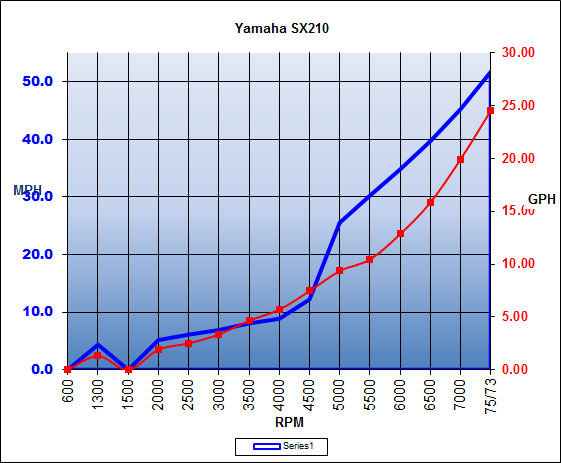
Specifications
| Length Overall | 21' 3'' / 6.48 m |
|---|---|
| Beam | 8' 6'' 2.59 m |
| Dry Weight | 3,172 lbs. 1,438 kg |
| Draft | 1' 5'' 0.43 m |
| Deadrise/Transom | 20-deg. |
| Max Headroom | open |
| Weight Capacity | 1,860 lbs. 844 kg |
| Person Capacity | 10 |
| Fuel Capacity | 50 gal. 189 L |
Price
See the price by becoming
a BoatTEST member.
Acceleration Times & Conditions
| Time to Plane | N/A |
|---|---|
| 0 to 30 | 6.0 sec. |
| Ratio | 0:00 |
| Props | 22.9 deg SS 3 blade |
| Load | 2 persons, full fuel, no water, 50 lbs. of gear |
| Climate | 93 deg., 66 humid.; wind: 0-3 mph; seas: calm |
Engine Options
| Tested Engine | 2 x 1049cc TR-1 High Output Yamaha Marine Engine |
|---|---|
| Std. Power | 2 x 1049cc TR-1 High Output Yamaha Marine Engine |
| Opt. Power | Not Available |
Captain's Report 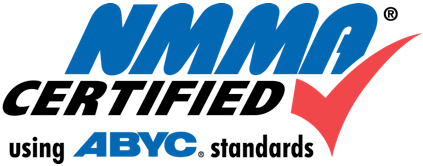 Learn More
Learn More
Watch Our Video
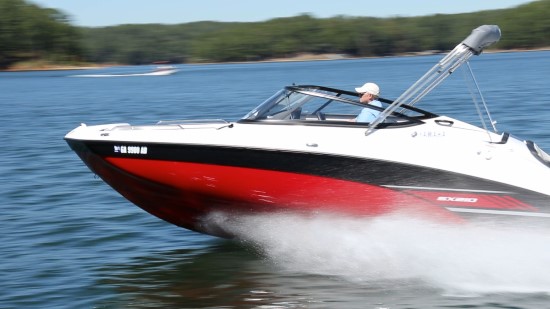
Overview
There are two boats in the Yamaha 210 Series, the SX210 and the AR210. The only difference between the two boats is that the SX210 has a typical Bimini top and the AR210 has a watersports tower. The rest of the boat's features are identical.
This practice of renaming a boat model based on the features is unique to Yamaha, and while it may seem odd, it actually makes sense. With this system in place, all the boats with the same model are the same and therefore easier to produce and control the costs. There are no options list that require changes to each boat that slows the process down. And with no options lists, there are no "up-charges" to each boat to put things on that should have been included in the first place. How many times have you seen filler cushions carry an extra price on a boat? Everyone buys it. Yamaha just includes it up front. But by keeping the process the same for each boat, no one can touch the company's pricing.
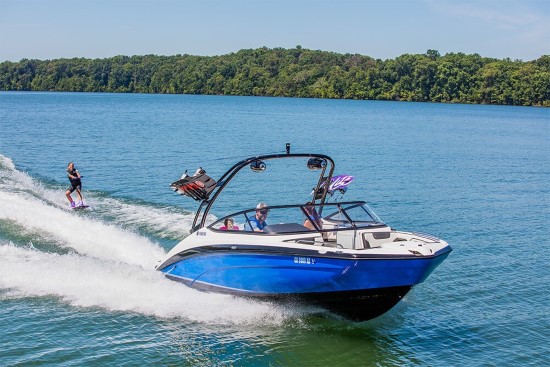
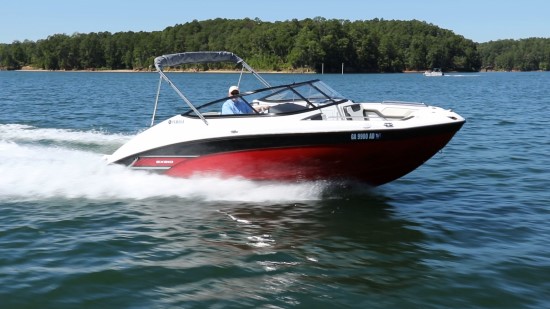
Test Results
The Yamaha 210 series have a LOA of 21'3" (6.48 m), a beam of 8'6" (2.59 m) and, with no outdrive, a draft of 1'5" (.43 m). With an empty weight of 3,172 lbs. (1,439 kg), full fuel and two people onboard, we had an estimated test weight of 3,892 lbs. (1,765 kg).
With twin TR-1 HO engines turning 7800 rpm, we reached a top speed of 43.8 mph. That speed also produced our best economy for distance cruising with the 17.3 gph fuel burn translating into a 114 mile range. For shorter cruises we can improve on the fuel burn by bringing the engines back to between 6000 and 6500 rpm for a fuel burn of 11.7 and 13.1 gph, respectively, with only a slight penalty in the range.
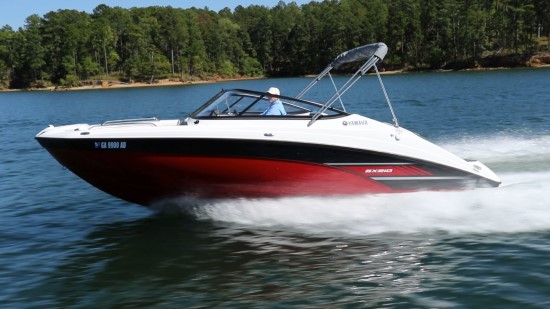
Handling
As for her handling it can be summed up in one word… exciting. That excitement level comes from two things, the response from the twin engines and the reaction of the Articulating Keel.
Articulating Keel
This single feature has contributed most to the sporty handling of the Yamaha lineup. It's an extension from the aft end of the keel, and connected to the steering nozzle of the jet pump exhaust. Now, instead of just the exhaust handling the steering, the articulating keel adds to that effect.
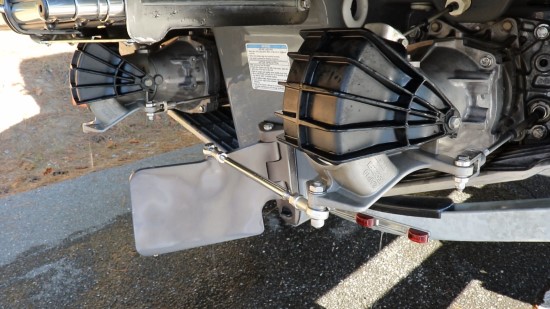
Off-Throttle-Steering
The second, and in our opinion more important, aspect of the articulating keel, is off throttle steering. Previously, when the power was taken off, so was the steering. Now imagine heading for a submerged object, and upon seeing it, you chop the throttle and turn away from the object only to have the boat continue in the same direction. Oops. Now, even when removing thrust from the equation, there's still steering and a dramatic increase in the safety level when operating jet boats.
With the combination of the Articulating Keel and twin TR-1 engines, the SX210 that we drove was exciting indeed. We had glass-calm conditions so we can't comment on how she handles chop other than crossing the wake of our camera boat. In that respect we found her to transition through the wake with no pounding effect and only minimal spray.
In turns, she'll bleed off speed only during hard turns, and if held to that turn she'll eventually slow enough to where she'll to that fun spin-out as jet boats do.
Features Inspection
Bow
Starting our tour at the bow, we immediately start to see some of the premium features on this boat such as the stainless steel handrails, and the heavy-duty marine-grade vinyl.
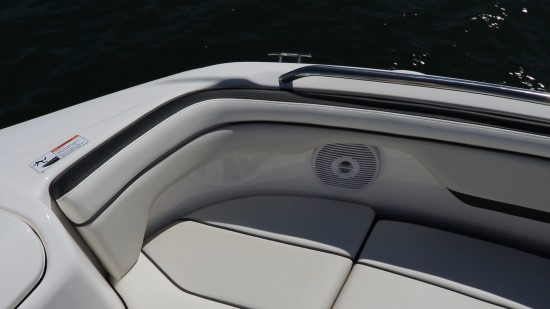
There's a definite feeling of roominess thanks to Yamaha carrying so much of the boat's 8'6" (2.59 m) beam so far forward. Because of this, we measured 6'4" (1.93 m) between the bolsters at the aft end of the bow dropping down to 4'8" (1.42 m) as we move forward.
The bow seating consists of the usual configuration of dual forward facing lounge seats but the comfort level is enhanced with their 1'10" (.53 m) width and 4' (1.22 m) length. Additionally, with 2'1" (.64 m) between the seats, occupants can sit while facing each other and still have plenty of legroom to spare.
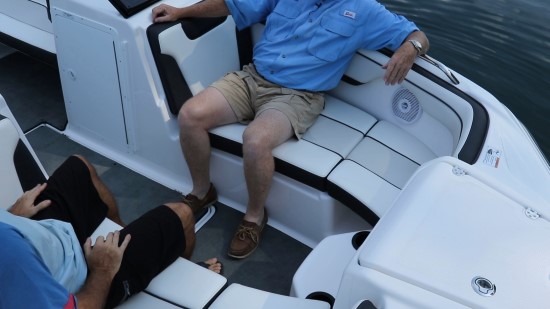
Diversity Comes Into Play
Padded bolsters wrap around the bow so we have comfort regardless of where we are, and speakers are recessed into the padding so they don't press into the small of the back.
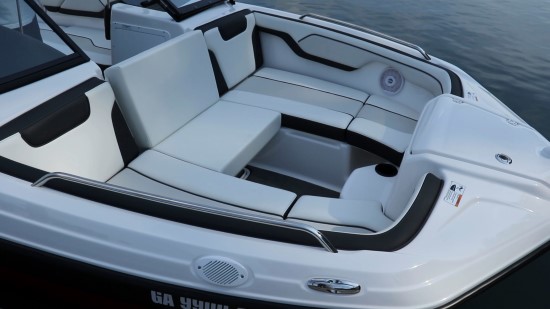
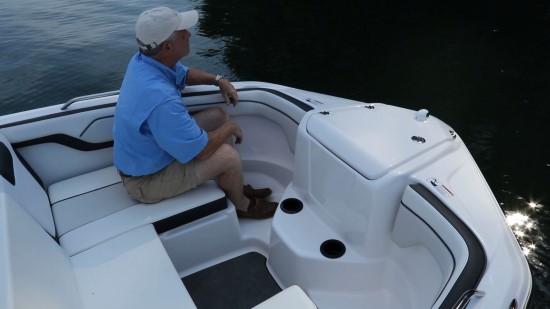
We start to see the diversity aspect with filler cushions that can convert the bow into three-across seating. We can also remove the forward cushions for turning the front of the lounges into seats with our feet on the deck. Previous models had a forward bolster strap to hold onto when sitting like this and we would like to see that return. And of course we can also convert the bow into a large sun pad by repositioning the same filler cushions from the three-across seating.
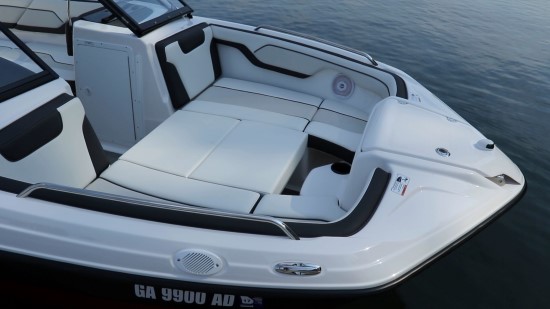
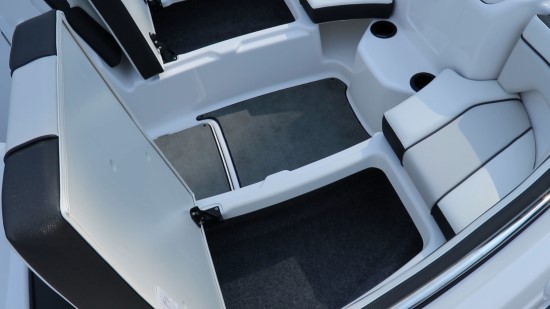
Use of Space
Yamaha's use of space is also notable in several instances. One is at the bow. 1000 Fully forward there's a step up to the foredeck for bow in docking. This also serves ae a nice launching off point for diving into the water.
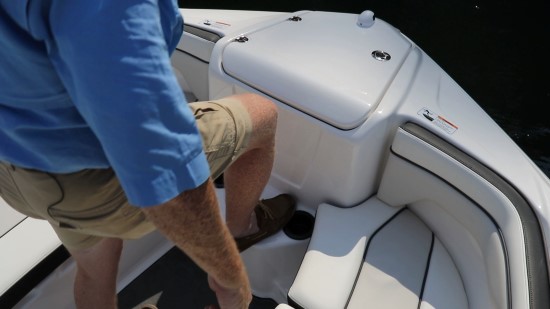
Under the hatch, however, there's a different story. Yamaha managed to accomplish what other's don't seem to be even willing to try. We're talking about creating a compartment that shares an anchor locker with the reboarding ladder. Here we see both, and it's this location that several other builders design the up-charge options and let the buyer pick between one or the other.
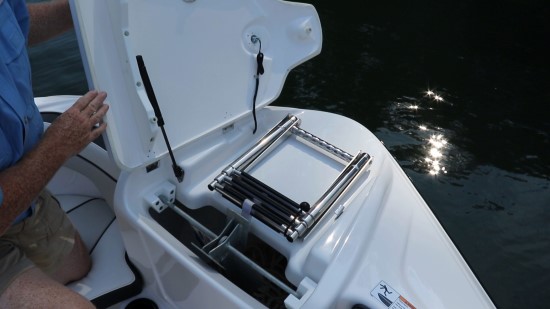
The hatch is held open with a gas-assist support strut… and we appreciate the lift and lock latch over the turn and lock latch that never seems to be turned in the right direction.
Here's another neat feature. We noticed that the anchor was held in place by wedges that the stocks dropped into, but there were no anchor keepers to hold the anchor from bouncing out. However, looking back at the hatch showed a shaped bracket underneath that does the job of holding the anchor down when the hatch is closed. A cleat strategically placed inside this compartment would be welcome and would give us a place to secure the rode other than having to use the pull up cleats off to the sides of the bow.
Walkthrough
The 25" (64 cm) walkthrough to the cockpit can be closed off with the closable windshield and a lower air dam that folds flush to the helm console when not in use.
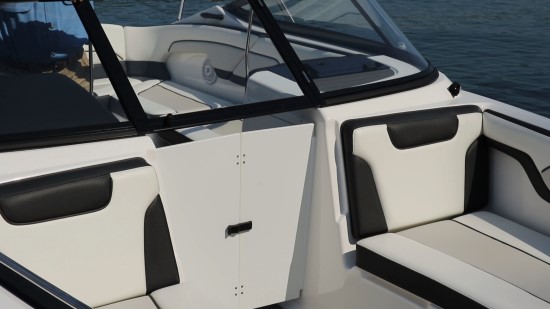
Storage Convenience
Right in this one area there are three separate storage areas, making it convenient to find what were looking for without having to search through the whole boat. The first of these compartments is to starboard, inside the helm console. Secondly we have the roomy sole storage compartment. We measured an opening 3'8" (1.12 m) long x 14 ½" (36.83 cm) wide, and the interior came in at 6'2" (1.88 m) long x 18" (45.7 cm) deep. This hatch gets a turn and lock latch, a support strut, and the opening is gasketed all the way around. Lastly, we have another storage area inside the port console that includes a 38-quart (35.96 L) carry-on cooler.
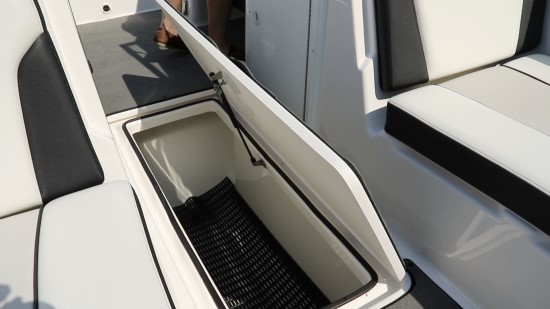
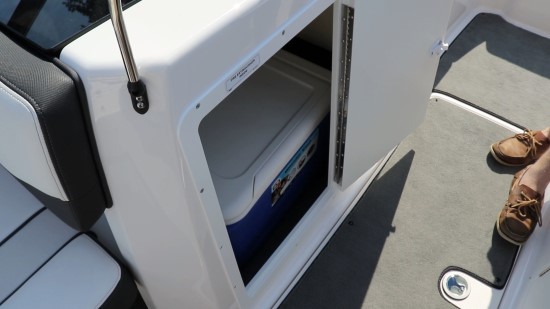
Helm
Looking at the helm, Yamaha created a good-looking panel with a vinyl brow over the two tachometers. And just to the right is another indication of how Yamaha doesn't get that affordable usually means stripped down and instead fitted the SX210 with a premium 4.3" (10.92cm) Connext touchscreen.
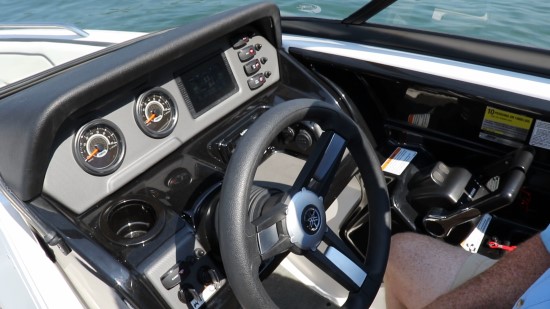
Connext Features
Not only does the Connext touchscreen provide information on data such as water depth, fuel, RPM, and speed but we can also scroll to trip info on max speed, miles per gallon, gallons per hour, average speed, and more…
When anchored it kicks into a whole separate set of display parameters with "float mode". Here the Connext will show a voltage meter and water depth. Plus, correctly assuming that we'll be hanging out and listening to the tunes for hours, and therefore running down the batteries, the system will sound an alarm when it's time to start the engine and recharge the batteries. All in an "affordable" boat.
All the way to the right of the panel, there are rocker switches that are lit when activated and there are circuit breakers alongside each one. The premium wheel is wrapped for comfort and mounted to a tilt base. To the left are the dual ignitions and single blower switch. To the right is an Infinity stereo with Bluetooth connectivity.
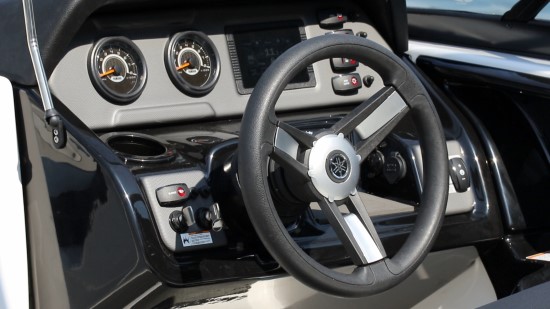
When driving the SX210 there's a comfortable armrest that makes operating a more relaxed experience. The helm seat is opened in the back, wraps around, slides and swivels 180-degrees.
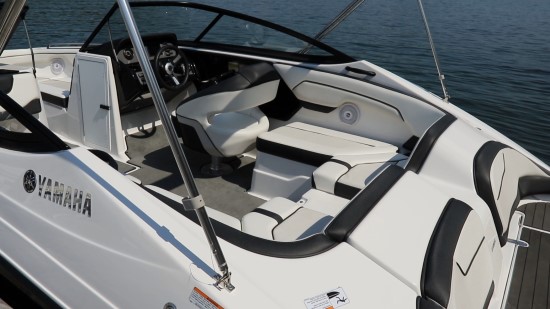
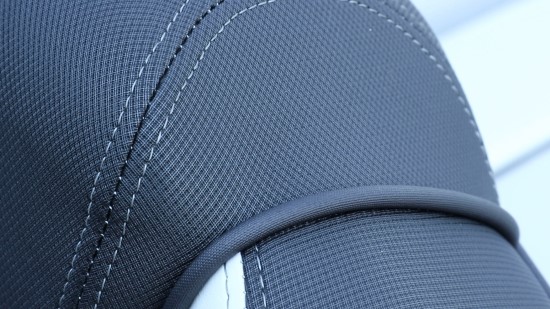
Cockpit
The cockpit features J-shaped seating that wraps around a standard (remember, no options here…) removable pedestal table. At the stern walkthrough, a non-skid step can be covered with a filler cushion. As is with the bow there are bolsters surrounding the cockpit and speakers are recessed beneath the bolsters. The heavy-duty marine-grade vinyl continues here. Open storage is under the port side seat. There's additional storage under the side seats, but here the available storage goes all the way back to the transom. Lastly, there's a deep glove storage compartment on top of the port console.
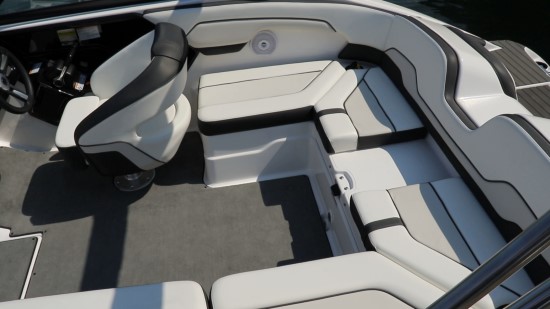
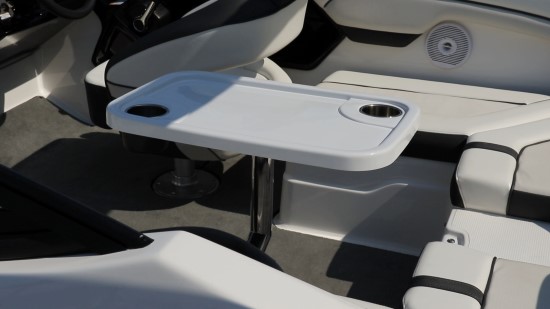
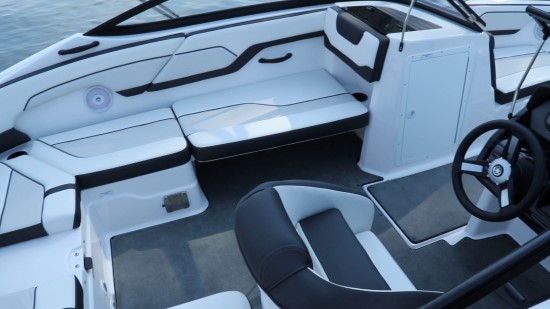
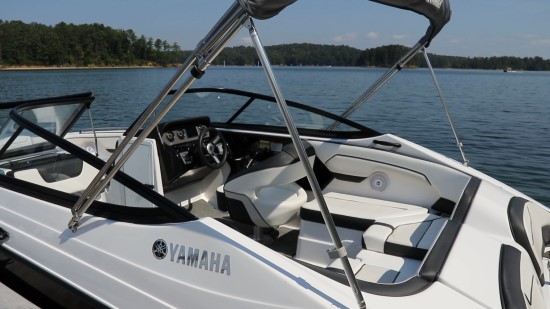
Engine Compartment
The aft seats, and the covered step to the transom walkthrough, make up the hatch to the engine compartment. A single latch is released and the dual support struts lift the hatch with no human effort. Inside this well soundproofed compartment are the two high output three-cylinder engines that are 40% smaller and 20% lighter than their M1 predecessors while still putting out more power.
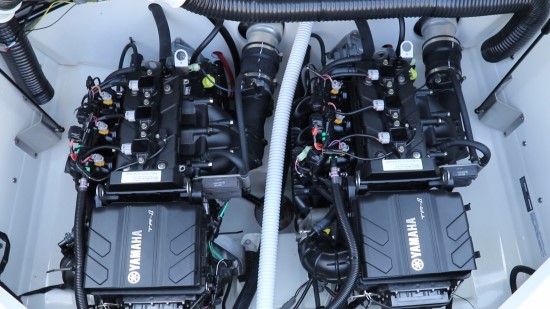
Home Grown
More importantly is that Yamaha builds these engines. This means that should any warranty issues arise, then it's Yamaha and Yamaha only that will step up to make it right. There's no passing the buck to be done here. Moreover, these engine were purpose-built specifically for the marine environment. Yamaha didn't simply add marine features to existing motorcycle engines. And the installation leaves plenty of room for maintenance and ease of daily engine checks, all of which should keep maintenance prices in check.
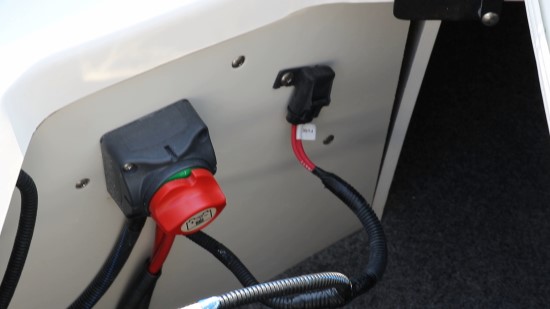
Stern
The stern of any Yamaha boat is instantly recognizable and has actually come to define the brand. In all of its models the stern consists of a two-tiered seating area with padded seatbacks for the upper level. With the 210 models, the upper level 19 ½" (49.53 cm) from the transom and the lower level projects another 16" (40.6cm). More of the premium vinyl is seen here, and putting the same upholstery in this decidedly unprotected environment is a testimony to the durability of the vinyl itself. Non-skid matting is on both decks and the table that we saw in the cockpit can be relocated to this position. Two center mounted grab handles aid in reboarding from the concealed ladder under the center of the swim platform, a location that would be unsafe in an outdrive equipped boat.
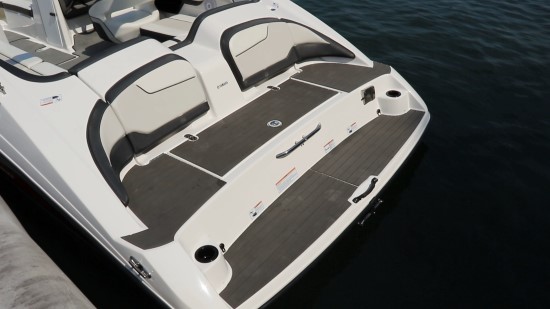
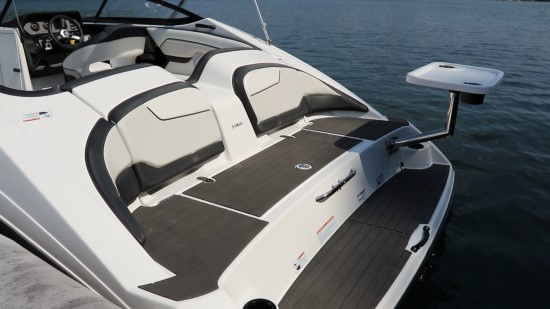
Jet Cleanout Port
A salesman of a traditional stern powered boat will be quick to tell you that jet boats have their impellers get clogged with debris, and they're right…. Sort of. It happens, but just not as much as they would have you believe, and probably not as much as running an outdrive into shallow water. See, the jet boat is more of a ducted fan, and if you run the boat through debris, grass, or over a plastic bag that some jack-wagon tossed into the lake, then yes, chances are the jet pump will become clogged.
This used to mean that you had to go swimming under the boat and clean out the clogged pump. Grating at the intake side took care of most of the problem but sometimes gunk can still get through. Yamaha has a clever take on the problem. It's called the clean-out port.
The upper deck of the swim platform is actually a hatch. Open it up and there are two ports leading straight down to the impellers. What you do is reach in, grab the large plug (since it wouldn't do to have the jets plasting water straight up, we have these plugs), turn the handle a ¼ turn and pull the plug up and out. Now we have clear access to the impeller, which is still under water, and we can pull out whatever is in there.
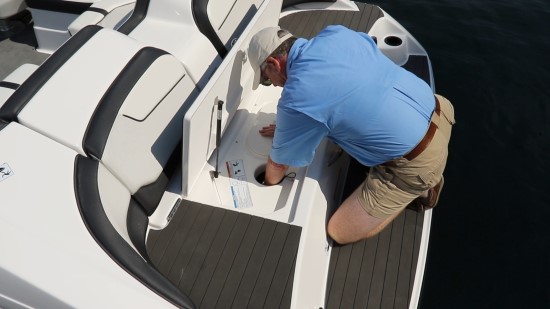
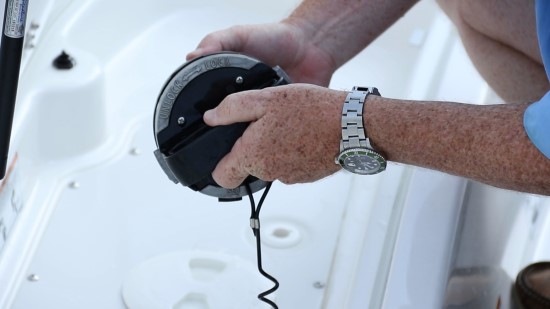
Now since the impeller is spinning whenever the engine is running, we need to make sure that the engine's are off when we do this. Trusting people to turn off the key and leave it off simply creates lawsuits, so Yamaha correctly went with the route of having a cut-off switch activated when the hatch is opened. The engines shut down and can't even be turned over when this hatch is opened.
Observations
We've said that the Yamaha 210 Series are affordable boats and we meant it. The SX version we tested comes in at $40,199 and the watersports tower equipped AR210 is priced at $42,499. We'll save you doing the complicated math and point out that this translates into $2,500 for adding a tower to the point. Is it worth it? It is if you plan on towing. Otherwise, for family outings and entertaining the neighbors with a relaxing cruise or coving, then stick with the SX version. Either way, it's a bargain that sterndrive boats can hardly touch.
Source: https://boattest.com/review/yamaha/3590_sx210#:~:text=With%20twin%20TR%2D1%20HO,top%20speed%20of%2043.8%20mph.

0 Komentar